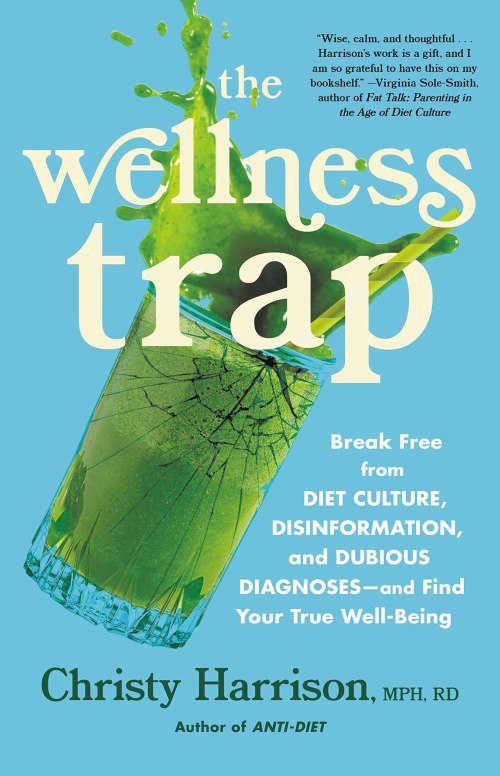Our editors independently select these products. Making a purchase through our links may earn Well+Good a commission
At Well+Good, we think a lot about the term ‘wellness’—including how to help our community (and ourselves) understand what it truly means to eat, move, feel, and be well. Sadly, diet culture likes to throw a wrench in our plans.
Experts in This Article
an intuitive eating coach, anti-diet dietitian
What’s more, all of us are constantly being forced to flounder in attempt to cut through the (deafening) noise of BS weight loss content on social media—not to mention day-to-day interactions. And as a result, discerning what foods, workouts, or forms of self-care are actually serving us has become a total mindf*ck. But as much as external influences may attempt to dictate how we live our lives, we’ve come to understand that wellness isn’t one-size-fits-all by any means. It’s about listening to one’s own body in order to determine the best way to achieve a well-balanced, healthy, and joyful lifestyle for you.
In the most recent episode of The Well+Good Podcast, we chatted with Christy Harrison, RD, leading anti-diet registered dietitian, journalist, certified intuitive eating counselor, and host of the podcasts Rethinking Wellness and Food Psych. Harrison has dedicated her career to breaking down serious societal issues that stem from modern wellness culture, as well as how to heal ourselves from the long and damaging history we’ve endured in the face of diet culture. (Using actual science! And expertise! And factual information!)
Listen to the full podcast episode here:
One of Harrison’s recent focuses? Practical, simple strategies folks can use to avoid falling into a “wellness trap,” as discussed in her groundbreaking new book, The Wellness Trap: Break Free from Diet Culture, Disinformation, and Dubious Diagnoses, and Find Your True Well-Being.
The Wellness Trap by Christy Harrison, RD — $26.00
In our conversation with Harrison, we dive deep into the prevalence of nutrition misinformation on social media and the real-deal risks of drowning yourself in (capital-W, capital-C) Wellness Culture. Plus: the expert shares effective ways to work towards a more positive, well-balanced relationship with food and your body. Because isn’t that kind of…the goal? More on that ahead.

3 ways to prevent yourself from falling into a wellness trap
1. Learn to identify wellness misinformation
According to Harrison, misinformation is one of the most significant issues in modern wellness culture. “I think wellness culture is some of the rockiest terrain we have in terms of [providing factual, evidence-based] information,” Harrison says, sharing that she coped with the struggle herself when managing personal health issues. Getting a proper diagnosis and finding the appropriate ways to treat her situation was extremely challenging, she says, due in part to the unending amount of conflicting information available on the internet—much of which was lacking in science-backed evidence.
“Social media is rife with disinformation, harmful diet advice, supplement regimens, and ideas being pushed on people to optimize themselves and heal from their chronic health conditions that often don’t have great treatments or support in conventional medicine. This can really pull people away from conventional medicine and away from science—and there is good evidence [to show that] going down these rabbit holes is where some people can even get exposed to potentially life-threatening misinformation,” Harrison says. She encourages folks to always take what they see on the internet with a grain of salt, perform their own background research, and speak with a healthcare practitioner to determine the best course of action for any nutrition-related situation.
2. Use the “SIFT” check method to fact-check wellness information
To sort through the health chatter online and find the appropriate science-backed research, Harrison suggests conducting a “SIFT” check.
“A researcher on media literacy and disinformation coined this term. SIFT stands for stop, investigate the source, find better coverage, and trace claims, quotes, and other information back to the original source. So regarding social media, it means to take a pause; don’t click, follow, subscribe, or share right away. And investigate,” Harrison says. This can help you discern the motives behind a post as well as fact-check the information, so you can apply what you deem appropriate and safe.
“SIFT stands for stop, investigate the source, find better coverage, and trace claims, quotes, and other information back to the original source. So regarding social media, it means to take a pause; don’t click, follow, subscribe, or share right away. And investigate.”—Christy Harrison, RD
3. Avoid social media content that’s intended to provoke a strong or radical emotion
Harrison’s emphasizes the fact that social media content that looks, sounds, or seems “extreme” is a red flag.
“Things that tend to get people to stay on the platforms longer [tends to be content] that provokes anxiety, moral outrage, disgust, anger, things that keep people clicking, sharing, and outrage Tweeting,” Harrison says. But according to her, this type of content can also quickly lead folks down a path of extreme dieting, an unhealthy relationship with food, or even “orthorexia,” an unhealthy obsession with “healthy” eating.
To stay away from this, Harrison suggests limiting mindless scrolling on social media platforms and searching for health-related information in a very targeted and methodical way. This might also mean cutting out social media altogether at times, which Harrison says has benefited her own mental health tremendously.
Listen to the full podcast episode here for more tips on navigating the wellness industry, as well as how to dig yourself out of a wellness trap.
Sign up for the Well+Good SHOP Newsletter
Get exclusive deals on wellness, beauty, fitness, and food products that have been hand-picked by our editors.
Got it, you've been added to our email list.









